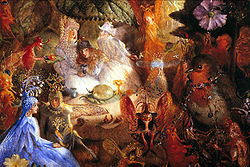
John Anster Fitzgerald
Encyclopedia

Victorian era
The Victorian era of British history was the period of Queen Victoria's reign from 20 June 1837 until her death on 22 January 1901. It was a long period of peace, prosperity, refined sensibilities and national self-confidence...
fairy painter
Fairy painting
Fairy painting is a genre of painting and illustration featuring fairies and fairy tale settings, often with extreme attention to detail. The genre is most closely associated with the Victorian era in Great Britain, but has experienced a contemporary revival...
and portrait artist. He was nicknamed "Fairy Fitzgerald" for his main genre. Many of his fairy paintings are dark and contain images of ghouls, demons, and references to drug use; his work has been compared to the surreal nightmare-scapes of Hieronymus Bosch and Pieter Brueghel
Pieter Brueghel
Pieter Brueghel may refer to:* Pieter Brueghel the Elder , painter* Pieter Brueghel the Younger , son of the above, a painter and copyist, also known as "Hell Brueghel"...
.
The year of his birth, in Lambeth Surrey, has been variously given, though 1819 is the likeliest. He was of Irish ancestry, the son of the minor poet William Thomas Fitzgerald
William Thomas Fitzgerald
William Thomas Fitzgerald was a British poet. He has been described as "one of the foremost loyalist versifiers of his day". He wrote patriotic poetry during the Napoleonic Wars, including Nelson's Triumph and Nelson's Tomb...
.
In 1849 Fitzgerald married Mary Ann Barr and they raised at least four sons and a daughter.
As an artist, Fitzgerald appears to have been largely self-taught. His work was first shown at the Royal Academy of Arts, London, in 1845; he also exhibited at the British Institution, the Society of British Artists, and the Watercolour Society. In the late 1850s he created a series of Christmas fairies for The Illustrated London News.
Fitzgerald gave his works titles that often gave little clear indication of their subjects; art dealers and collectors frequently re-named them, causing great confusion in his artistic canon. Some of Fitzgerald's titles, like The Pipe Dream and The Captive Dreamer, suggest that "Fitzgerald was familiar with the opium
Opium
Opium is the dried latex obtained from the opium poppy . Opium contains up to 12% morphine, an alkaloid, which is frequently processed chemically to produce heroin for the illegal drug trade. The latex also includes codeine and non-narcotic alkaloids such as papaverine, thebaine and noscapine...
dens which, with choral
Chloral hydrate
Chloral hydrate is a sedative and hypnotic drug as well as a chemical reagent and precursor. The name chloral hydrate indicates that it is formed from chloral by the addition of one molecule of water. Its chemical formula is C2H3Cl3O2....
and laudanum
Laudanum
Laudanum , also known as Tincture of Opium, is an alcoholic herbal preparation containing approximately 10% powdered opium by weight ....
, represented the Victorian drug scene."
Fitzgerald created "remarkable fairy pictures of pure fantasy, rarely based on any literary theme." His paintings often use brilliant colors, especially reds, blues, and purples, as in The Captive Robin shown here. He produced a major series of paintings on the Cock Robin
Cock Robin
"Who Killed Cock Robin" is an English nursery rhyme, which has been much used as a murder archetype in world culture. It has a Roud Folk Song Index number of 494.-Lyrics:...
theme—among others, Who Killed Cock Robin?, Cock Robin Defending his Nest, and Fairies Sleeping in a Bird's Nest (the last furnished with a frame made out of twigs).
Fitzgerald had limited connections with other artists, or, apparently, other human beings. He existed mainly at his London club, the Savage Club
Savage Club
The Savage Club, founded in 1857 is a gentlemen's club in London.-History:Many and varied are the stories that have been told about the first meeting of the Savage Club, of the precise purposes for which it was formed, and of its christening...
. Fellow members, reminiscing of him post mortem, recalled that he was adept at imitating the great actors of earlier generations, Edmund Kean
Edmund Kean
Edmund Kean was an English actor, regarded in his time as the greatest ever.-Early life:Kean was born in London. His father was probably Edmund Kean, an architect’s clerk, and his mother was an actress, Anne Carey, daughter of the 18th century composer and playwright Henry Carey...
, Charles Kemble
Charles Kemble
Charles Kemble was a British actor.-Life:The youngest son of Roger Kemble, and younger brother of John Philip Kemble, Stephen Kemble and Sarah Siddons, he was born at Brecon, South Wales. Like John Philip, he was educated at Douai...
, and William Charles Macready
William Charles Macready
-Life:He was born in London, and educated at Rugby.It was his intention to go up to Oxford, but in 1809 the embarrassed affairs of his father, the lessee of several provincial theatres, called him to share the responsibilities of theatrical management. On 7 June 1810 he made a successful first...
.
The final work Fitzgerald exhibited at the Royal Academy, in 1902, was a picture of Alice in Wonderland. Twentieth-century art forgers have been active in creating phony Fitzgerald fairy pictures. The forgeries were discovered when analysis revealed modern pigments.

